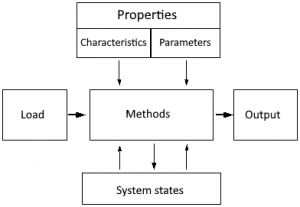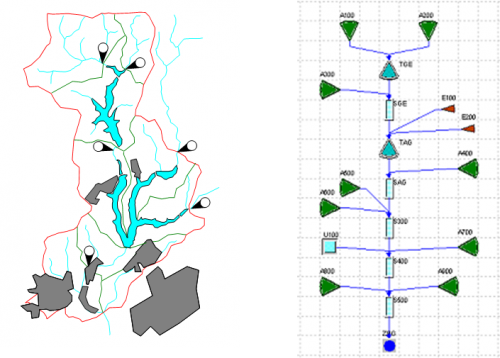Model Concept
In order to model a river basin, the water resources system must be converted into a mathematically usable representation. The simulation model requires a mathematically defined representation of a water resources system. For this, reality has to be abstracted, divided into hydrological or hydraulic processes, and then be put into algorithms. The result of the abstraction are different system elements. The most important properties of a system element are listed below.
.
- A system element integrates related transport and storage processes to form one calculation unit.
- A system element has properties in the form of characteristics and parameters.
Characteristics are clearly definable features of system elements. Parameters are also characteristics of system elements, but they are subject to calibration and verification. - System elements have corresponding methods according to their type, which describe the behaviour of an element. Loads acting on the element trigger system reactions and states using these methods.
- Under the same loads as well as the same characteristics and parameters, the methods always provide the same system reactions and states.
If the system elements are now arranged in such a way that they reproduce the flow relationships existing in reality, the water resources system is then ready for a mathematical simulation. This process, also known as structural analysis, determines the geographical relationships and interactions. The result of a structural analysis is the flow network. The interaction between elements takes place via the load and the element outlet, where in most cases, the load corresponds to an inflow and the outlet to an outflow. The outlet of one element may for example correspond to the load (inflow) of the next element downstream. Almost any water resources system can be simulated by using different arrangements of the elements.
System elements are the hydrological building blocks of the river basin model. Linking these together according to their flow relationships produces the flow network, and also the flow network map as a visual representation of it.
The more detailed you carry out the spatial and temporal discretization, the more information can be gained about the system itself. However, the highest possible resolution of a system does not always provide the best advantage, because a closer examination requires more characteristic values and parameters, some of which may not be available in sufficient quality and are therefore difficult to estimate. Thus, there is a suitable degree of abstraction for each task, which can however be subject to change due to increasing requirements and improved quality of available input data.
The collection of characteristics and parameters can be described using the term system data analysis. The collection of the control relationships and their implementation for the simulation is called the operational analysis. From the latter, a kind of second system logic arises, which does not contain flow relations but the logical connections of the state variables to derive the output decisions. It can be called control logic.

